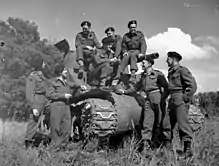Sherbrooke Fusiliers Regiment
The Sherbrooke Fusilier Regiment was a Second World War Canadian armoured regiment created in 1940 with officers and men from two Militia regiments in Sherbrooke, Quebec. The name is a blend of Les Fusiliers de Sherbrooke, a francophone infantry unit, and the Sherbrooke Regiment, an English-speaking machine gun unit. The armoured corps lineage of the Sherbrooke Fusilier Regiment is carried forward by the present-day The Sherbrooke Hussars.

| 27th Armoured Regiment (The Sherbrooke Fusilier Regiment) | |
|---|---|
| Active | 1940–1946 |
| Country | Canada |
| Branch | Canadian Army |
| Role | armoured regiment |
| Size | Regiment |
| Motto(s) | Droit au but |
| Decorations | . |
History
The regiment was formed as an infantry unit, The Sherbrooke Fusiliers Regiment in 1940, a plural form of the name which lasted only a short time. It was converted to an armoured regiment in 1942, becoming the 27th Armoured Regiment (The Sherbrooke Fusilier Regiment). Initially part of the 4th Armoured Brigade, by the time it went into action, it was in the 2nd Canadian Armoured Brigade.
The most prominent former member of the SFR is Sydney Valpy Radley-Walters, who was later Director-General Training and Recruiting Canadian Forces. During the war, Radley-Walters had three tanks shot out from under him and was wounded twice. He ended the war a lieutenant-colonel decorated with a Military Cross and Distinguished Service Order. The second most important artifact from the Second World War, after the guidon, is a Sherman tank named "Bomb". This M4A2 Sherman[1] landed in Normandy on D-Day, served on the front lines throughout the campaigns from June 1944 to May 1945 in Germany without being destroyed or knocked out. It was returned to Canada after the war, and has been a strong reminder of the sacrifices of the regiment.
During Operation Totalize, A Squadron of the regiment, commanded by Radley-Walters, was in a support position with six 75 mm Shermans and two 17-pounder Sherman Fireflies in a walled chateau compound when the SS tank commander Michael Wittmann, one of the highest scoring German tank commanders of the war, led a heavily armoured counterattack on 8 August 44 near Gaumesnil attempting to drive a seam between British and Canadian formations. The Sherbrooke tanks were placed behind stone walls with holes knocked out for firing positions about 300m broadside to the German platoon's axis of advance. The Canadian tanks quickly destroyed two Tiger tanks, two Panzer IVs and two self-propelled guns, while British tank fire destroyed three other Tigers as the German counterattack collapsed.[2] Wittmann and his crew in their Tiger I tank were killed by tank fire from either British or Sherbooke tanks.[3][4] Modern investigations and interviews suggest the Sherbrooke tanks actually destroyed the German Tiger tank number 007 that was commanded by Wittmann as the British tanks, of 3 Troop, A Sqn, 1st Northamptonshire Yeomanry, were probably too far away.[5]
The unit was demobilized in 1946, and its battle honours shared equally by the two predecessor units the Sherbrooke Hussars and the Les Fusiliers de Sherbrooke.
References
- according to census number T152656 this number was assigned to a Sherman 111 or M4A2
- Mark Zuehlke, "Heroes and Villains: Radley-Walters & Wittmann", Legion Magazine, August 8, 2017
- https://www.youtube.com/watch?x-yt-ts=1421914688&feature=player_embedded&x-yt-cl=84503534&v=mCNz7OC8YIs
- https://www.youtube.com/watch?v=fYXns_x_w_0
- Brian Reid, No Holding Back: Operation Totalize, Normandy, August 1944 (2005) p. 410.